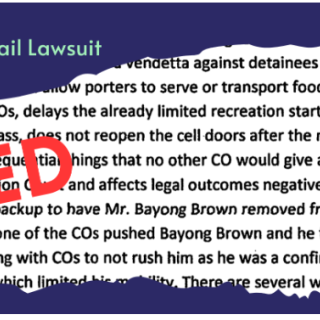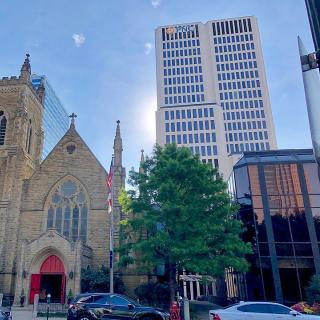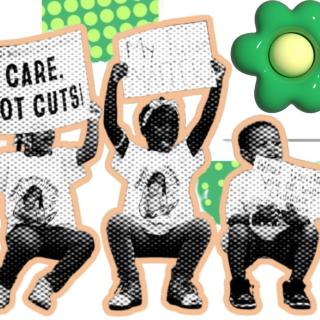On Sunday, February 5 at about 4pm, I get a phone call from a friend who has access to police scanners and phone calls. He tells me there’s been an officer-involved shooting and have I heard anything about it?
A few minutes before hand, I’d mostly ignored a Facebook Live feed an organizer friend of mine had started regarding the same incident: it wasn’t that I dismissed this organizer’s work; it was that, ten years into my own work, I have come to realize that personalizing every tragedy in this city wears on a person’s mental health and physical well-being. I’m in my early 40s. Too many of my friends and comrades have either taken their own lives or lost them “accidentally” for me to be less than cautious about such happenings.
I’ve been in close proximity to over a dozen families whose sons, daughters, fathers and occasionally mothers have been abused, neglected, or killed by police in the Columbus area. In spite of this, I’m not purely a police abolitionist: if someone decides to take a meat cleaver to an open crowd of innocent bystanders in, say, a college campus – as someone did on the OSU Campus in late November of 2016 – I want a professional trained in lethal force to neutralize the immediate threat. Putting that burden on any community is too much to ask of its members. Furthermore, it’s my firm belief that if we’re truly a nation of laws – to which everyone who’s ever honestly taken an oath of office has affirmed – then the people to handle similar situations need to strictly adhere to those laws and, as such, do so without bias.
The application of some of these laws stretches the imagination. The recent legal exonerations of men like officers Zachary Rosen – who sent the final shot into the back of 23-year-old Henry Green in the summer of ’16 – and Bryan Mason – who shot 13-year-old Tyree King in the back three months later – make me question whether the laws by which we’re supposedly governed matter at all.
Coroner’s reports listed both of those deaths as “homicides” – which, with the exception of one known case – is illegal and punishable with prison time at the very least.
Two days after news of the latest Columbus police shooting went public, the Department of Justice announces that it has concluded its Roadmap to Implementation from its Community Oriented Policing Services (COPS) office. The report had been requested by the Mayor Ginther’s office in April of ’21 – the day before a group of Black civic and religious leaders and allies called the Columbus Police Accountability Project – of whom I’m in leadership – had called for a thorough practice-and-pattern investigation of the Columbus Division of Police and their associates for decades’ worth of obviously racially biased and excessively violent behavior.
The COPS report frames their recommendations based upon the request sent by the City. To that effect, the COPS report (and don’t you love the acronym?) mentions the following in its introduction:
“The COPS Office strongly encourages CDP to conduct an independent review of their use of force practices and policies as they see fit given that this was outside of the scope of this review.
On Monday, February 6th – the day before the DOJ COPS report is released – The Columbus Division of Police announces that they’ll release the bodycam footage of one of their officers shooting Michael Cleve the previous day. I watch the video on the 7th thanks to 10TV’s release. The video shows two officers searching for a suspect of an unspecified nature. They see a black pickup truck pass. One of the officers – Joshua Ohlinger – is heard saying:
“Oh [bleep] – That’s Mike Cleve!” (His full name is Mike Cleveland.)
Mike pulls into an alley. The police car stops behind. He gets out of the car and begins to run, dropping something out of his right pocket along the way. The officers get out of their car and pursue. Ohlinger pulls out his taser, then holsters it, pulls out his pistol, and fires six shots at Cleveland as he runs. One shot clearly hits Cleveland just above his coccyx or tailbone.
In their press conference the following day, Police Chief Elaine Bryant offhandedly remarks that Cleveland might have been driving under a suspended license. No other reason for the pursuit or the discharge of the weapon is given.
A day or two later, news outlets reveal that Ohlinger had shot a teenage suspect in the back in August. After a brief administrative leave, he resumed full duties.
The day after news of Ohlinger’s history becomes public, I get a call from my older brother, who leads the call mentioning this fact about Ohlinger. I am the middle child of my father’s children and the eldest of my mother’s. My brother is dad’s first, and his (my brother’s) mother is a retired Columbus City School employee. When he calls, I assume that the conversation will revolve around why I hadn’t called him in a few weeks, as is my usual pattern. I’m wrong.
“That cop shot somebody else! Did you know that?”
“Yes,” I tell him.
“Mike Cleveland is my cousin.”
My brother is my father’s first child from his first marriage and I’m his first from his second – is meaning that while I might have met Cleve in passing, he is only loosely related to me through his mother. Still – in a decade’s worth of living in Columbus, working with families, organizers, advocates and activists – this is the closest I’ve come to being directly related to a victim.
Yesterday morning – February 9 – I receive a phone call from one of the community activists who’d gathered on the scene of the shooting. She tells me that a source from within the hospital where Cleve had been reported in “stable condition” has succumbed to his wounds. I contact a local reporter to verify this.
She calls the hospital. She’s told he’s not there.
She calls the coroner’s office. She’s told he’s not there, either.
She calls Jackson Pike correctional facility. She’s told he’s not there.
I call my brother. He tells me he’ll contact the immediate family and get back to me.
I’m reminded in that moment of all the families I’ve met: the mothers, daughters, fathers and sons who spent hours of uncertainty leading to tragedy; the mother forced to watch her son shot by police while he’s roused from sleep in the middle of the night; the daughter reliving the moment that her father is shot inside of a garage; the grandmother who watches as her grandson walks into his apartment carrying Subway sandwiches and is shot in the back six times.
Til now my fears and frustrations with these families has been mixed with a relative objectivity, and a notion, again, that if we’re a nation of laws, we need, as a public, to press our lawmakers to impress upon their employees in law enforcement that we are, in fact, a nation of laws. In spite of the fact that the application of those laws has been obviously skewed toward protecting those in law enforcement rather than those we’re told they’ve sworn to “protect and serve.”
I know the image of Cleve leaving his car, dropping something, running in between two houses, and then being shot in the back by Ohlinger after the former has pulled out a taser, then changes his mind to shoot Cleve with his pistol, will have varying effects on the people who view it. I’m sitting in my brother’s living room as I write this: his two sons – 20 and 21 – sit eating lunch. (Today they’re both off work.) They’re both tall, athletic young kings – in other words, the exact demographic typically targeted by a rogue portion of the police force that not even the Department of Justice seems willing to hold to account.
Living in this city, it’s a wonder there aren’t more absolute police abolitionists among us – even if, for now, I’m not quite one of them.
We might be a nation of laws, but the (mostly) men who make and enforce those laws have an inordinate amount of sway over how and to whom they’re applied.




